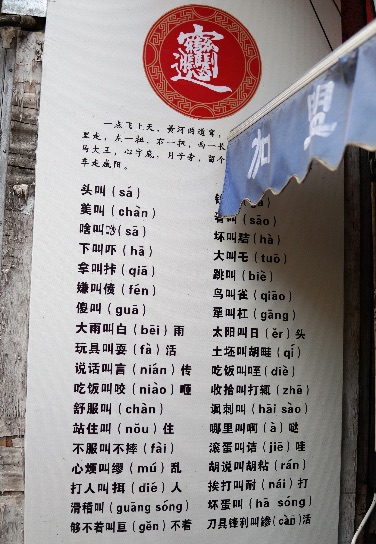Shaanxi topolect
« previous post | next post »
Adrian Thieret spotted this poster in downtown Xi'an this summer:
Shaanxi speech (Shǎnxī huà 陝西話) is supposed to be a northwest "dialect" of Mandarin, but it is evident from this word list how widely it differs from Modern Standard Mandarin (MSM) (Pǔtōnghuà 普通话 / Guóyǔ 國語 / Huáyǔ 華語). I'll just mention a few of the nearly three dozen items on the list to give an idea of how different they are from MSM (note that many of the Shaanxi lexemes are pronounced with syllables that are impermissible in MSM and are written with special characters [cf. Cantonese]):
tóu 头 ("head") sá
měi 美 ("pretty") chàn
shà 啥 ("what") sā
xià 下 ("down; under; below") hā
ná 拿 ("take") qiā
shūfú 舒服 ("comfortable") chàn
zhànzhù 站住 ("stop; stand still") nǒu
huájī 滑稽 ("funny; humorous") guāng sóng
tiào 跳 ("jump") biè
chīfàn 吃饭 ("eat") diè
fèngcì 讽刺 ("satirize") hài sào
huàidàn 坏蛋 ("scoundrel") hā sóng
A much longer list of Shaanxi expressions may be found here. Note that many Shaanxi usages go back a thousand or two thousand years ago. The capital of Shaanxi Province, Xi'an, was a historically very important city that lay at the eastern end of the so-called Silk Road (the transcontinental trade routes that already existed long before silk was traded along them) and just south of the Ordos, which was a vital zone of interaction between the steppe and the sown.
Oh, if you're wondering what that strangely complicated character at the top of the poster is, we've already run into it on Language Log:
- "Writing Chinese characters as a form of punishment" (11/1/15)
- "Complex 'character test' facing tardy Chinese students" (BBC, 10/29/15)
- "The Awful Chinese Writing System" (Lingua Franca, 1/20/16)
That's the whimsical, whacky character for "biang", a type of noodles that is popular in Shaanxi province.

Andreas Johansson said,
September 8, 2018 @ 7:27 am
Xi'an, was a historically very important city that lay at the eastern end of the so-called Silk Road
It was also, of course, the capital of various Chinese dynasties, most notably perhaps the Tang (at which time it was called Chang'an).